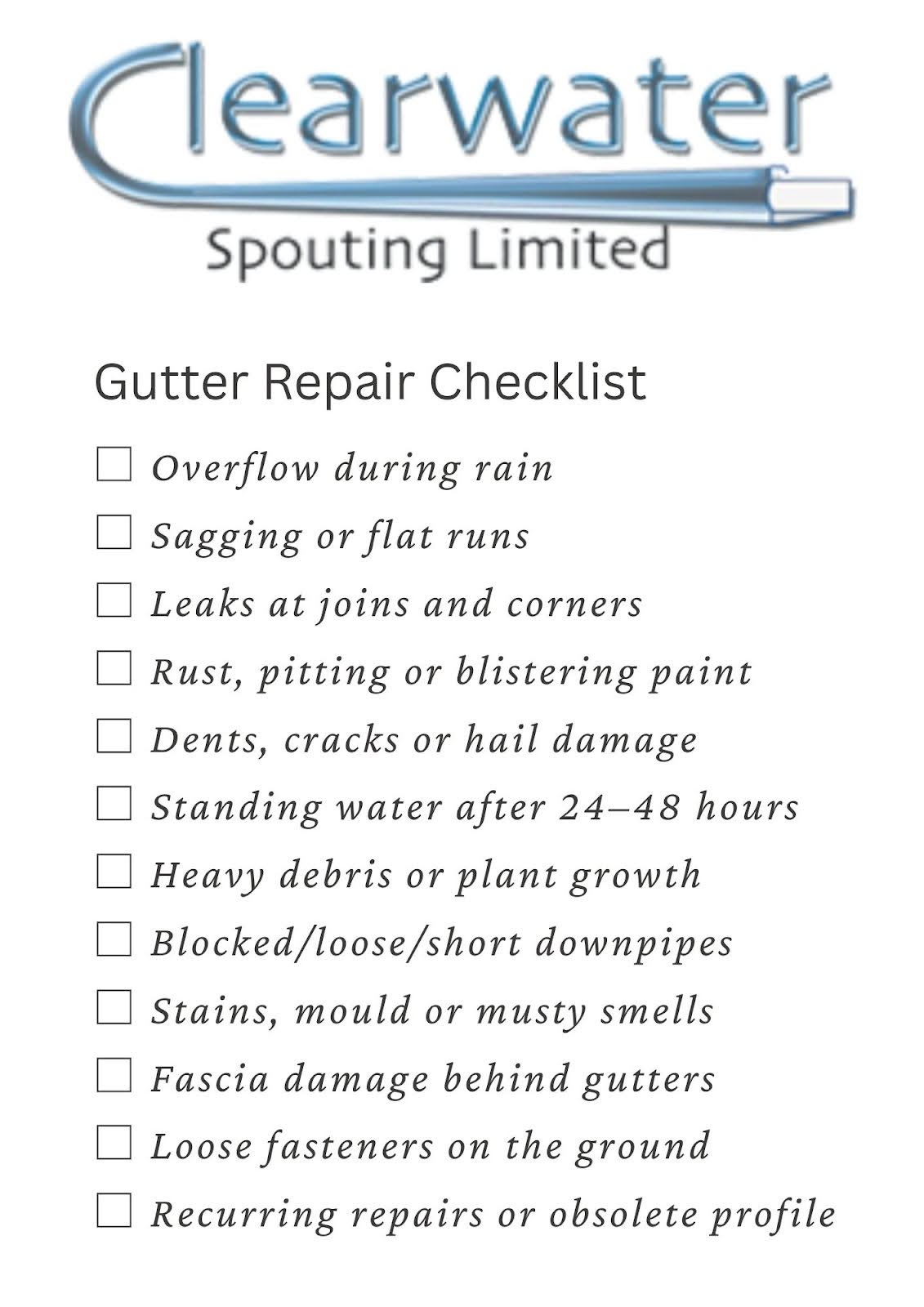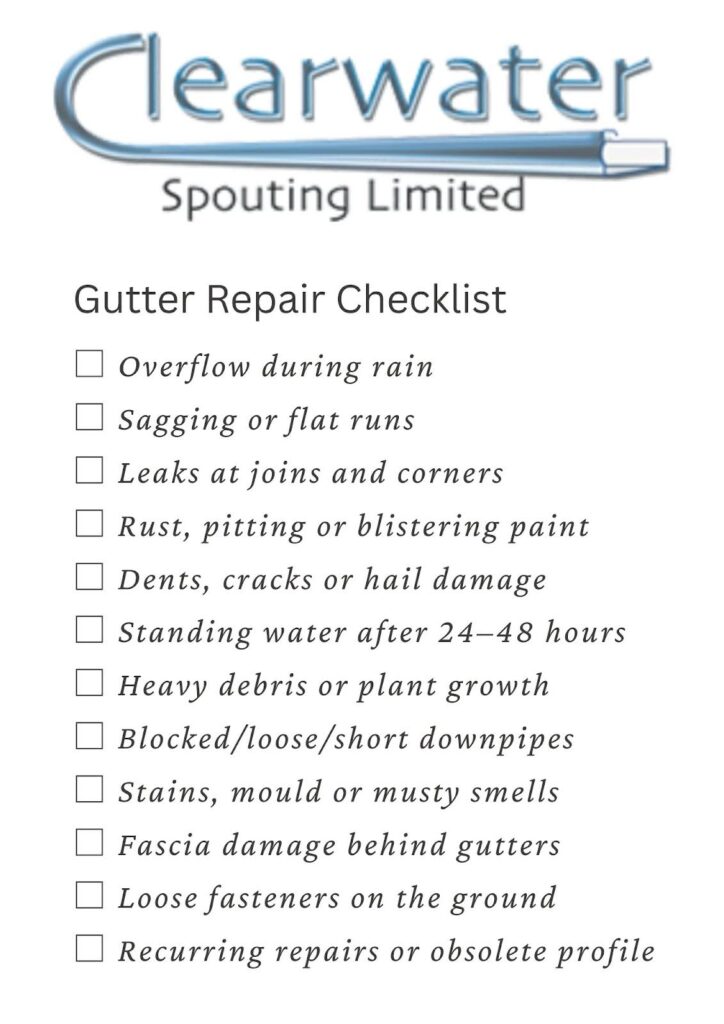
September 2, 2025
If your gutters aren’t doing their job, water finds a way into places it shouldn’t, either under the roof, behind the cladding, and around the foundations. Left unchecked, a small gutter issue becomes a big, expensive leak. Use this practical, homeowner‑friendly checklist to spot problems early and decide when to bring in Clearwater Spouting for a professional fix or full replacement.

Why this matters in New Zealand
Our homes face frequent heavy downpours and wind‑driven rain. The New Zealand Building Code (clause E2 – External Moisture) exists for a reason. Your roof, spouting and downpipes must move water away before it can cause damp, rot or mould. Good gutters are part of that weathertight “system,” not an afterthought.
How to use this checklist
Walk the perimeter of your home after a rain event and again on a dry day. Look up from ground level with a torch. If it’s safe, view the roof edge from a ladder; if not, take photos from the ground or a window. Note anything that looks out of line, damp, stained or rusty. If in doubt, document issues and call a qualified spouting specialist. Here’s what to check:
Overflow during rain
During heavy rain, do you see water pouring over the front of the gutter, splashing onto decks or pooling beside the house? Overflow is the classic sign of a blockage or an undersized/down‑sloped section and needs attention quickly to protect cladding and foundations.
Sagging or uneven runs
Gutters should follow a gentle, consistent fall toward outlets. If sections dip, bow, or sit flat, water will pond and accelerate rust, seam failure and overflow. Look for loose brackets, pulled‑out screws, or detaching fascia.
Drips at joins and corners
Seams, mitres and stop‑ends are high‑stress points. Damp streaks, water marks on the fascia, or staining on the soffit beneath corners indicate sealant failure or corrosion at joints that need either resealing or replacement.
Rust, pitting or paint blistering
Any exposed metal will corrode faster, especially where water sits. Check for orange staining and bubbling paint or pin‑holes. Small patches can sometimes be treated; widespread pitting usually signals it’s time to replace sections.
Cracks, dents and hail damage
Impacts from ladders, branches and hail can crease the gutter profile or split thin corners. Even minor deformation can interrupt flow and trap debris. If the spouting profile is damaged expect possible blockages.
Persistent standing water
After 24 to 48 hours of dry weather, look for shiny puddles inside the gutter. Standing water means inadequate fall, a sag, or debris building a “dam.” It can create and speed up corrosion.
Debris build‑up and plant growth
Leaves, silt, moss and seedling “little gardens” inside the channel are more than cosmetic. Sometimes they stop water getting to the downpipes. If you need to clean than a couple of times a year, maybe you should consider leaf guard options that suit New Zealand conditions.
Blocked, loose or short downpipes
Downpipes should be securely connected to outlets, uncrimped, and sized for the catchment. Watch for leaks at every join. Ensure the final discharge sends water well away from the house, not onto paths where it can pond and re‑enter under doors.
Water stains, mould or musty smells
Inside or outside, discoloration on soffits, ceiling edges or top corners of walls often traces back to gutter leaks. A musty “damp” smell in eaves after rain is a red flag—don’t ignore it.
Fascia or bargeboard deterioration
Peeling paint, swollen timber and soft patches behind the gutter indicate long‑term moisture. Fix the source or you’ll be repainting and replacing fascia again soon.
Nails, screws or brackets on the ground
Fasteners sometimes work loose in strong winds. If you’re sweeping up screws or old spikes, a section is probably insecure. Re‑fixing with the right hangers restores alignment and fall.
Age and recurring call‑outs
If you’re patching the same section every winter, the gutter profile is obsolete, or leaks keep returning, replacement can be more economical than the next repair—especially if you’re planning exterior painting or a roof refresh anyway.
DIY fixes vs professional help
Simple clearing of leaves and silt is a safe DIY task when done from the ground with a hose attachment. Anything involving ladders, roof edges, live electrical wiring, or resealing/fall correction is best left to trained spouting / roofing specialists.
Repair or replace? A quick rule of thumb
Repair makes sense when the gutter is generally sound, issues are localised (for example, one faulty joiner), and you’re not facing widespread rust or deformation.
Replace when there’s repeated leaking, pervasive corrosion/pitting, obvious mis‑fall across long runs, or a profile that no longer meets demand.
Maintenance rhythm that actually works
Plan two clean‑outs per year once after autumn leaf‑drop and again in late spring plus a quick check after major storms. Trim back overhanging greenery and check that rainheads and leaf guards (if you have them) are clear. If it’s easy accessible and safe you should test flow with a hose from the highest point. Keep a small notebook or phone photos so you can track what’s getting worse and what’s holding steady.
How Clearwater Spouting helps
We’re specialists in spouting, downpipes and rainwater solutions, basically from spouting repairs and resealing to full system replacement and internal‑to‑external gutter conversions. We assess the roof catchment, gutter fall, outlet sizing and downpipe layout as one system, then recommend the most durable option for your home and budget. You will get a clear proposal, before/after photos, and tidy, safe workmanship.
Don’t let minor gutter glitches become major repairs! Book your free on‑site assessment at 0800 RAINMAN with Clearwater Spouting today. We’ll find the cause, fix it properly, and keep water where it belongs – out and away from your home!
Quick reference checklist (save this)
□ Overflow during rain
□ Sagging or flat runs
□ Leaks at joins and corners
□ Rust, pitting or blistering paint
□ Dents, cracks or hail damage
□ Standing water after 24–48 hours
□ Heavy debris or plant growth
□ Blocked/loose/short downpipes
□ Stains, mould or musty smells
□ Fascia damage behind gutters
□ Loose fasteners on the ground
□ Recurring repairs or obsolete profile
Got ongoing issues and thinking about a bigger upgrade?If you have internal gutters and consider converting to an external system ask us about options and timing!